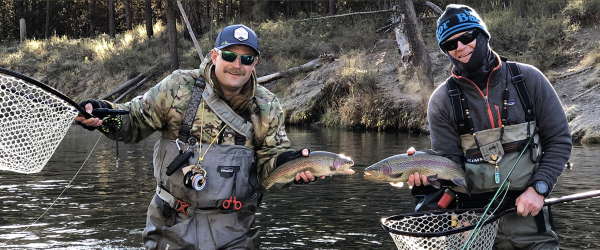Seven Tips for Catching More Trout this Winter from Oregon DFW
 |
7 tips to catch more trout this winter
Dedicated fly-anglers don’t stop fishing in the winter, instead they adjust their tactics to the colder conditions.
Oregon’s popular trout rivers take on a different character in winter. The barren landscape reveals a different sort of beauty, the crowds diminish and the fishing becomes more challenging.
For some, it may be enough “to just be there.” But if your plans include actually catching a fish, here are seven tips that may help improve your chances.
1
Go small and light. Clear, slow water, smaller insects and wary fish call for smaller flies and lighter tippet than you might use the rest of the year.
- Downsize your flies. A dominate food source for trout in the winter are teeny, tiny midges that are best mimicked by teeny, tiny flies – like size 16 and smaller.
- Lighten your tippet. If you normally fish 4X, switch to 5X. This will let the smaller flies move more naturally, and avoid spooking fish hanging out in slower waters – where they have more time to scrutinize your fly.
2
Hope for dry fly action but plan to nymph. Winter fly-fishing is a nymphing show. Consider a double-nymph rig with a smaller midge pattern on top and a weighted stonefly below, to help keep your flies near the bottom of the river.
But also be prepared for the occasional hatch with a selection of Griffith’s gnats and small blue wing olives.
3
Look for trout in slower waters. Trout metabolism slows in the winter. They’re eating less and looking for ways to conserve energy, like getting out of the heavier currents into quieter waters.
Back eddies, off-channel areas, and the inside of current seams can all be places to look for winter trout.
4
Cover the water thoroughly. A fish won’t move far to take a fly (slower metabolism and all that), so you’ll want to put your fly right in front of its nose. Cover the water methodically to increase your changes of hitting a fish.
5
Sleep in. There’s no need to hit the water at daylight when it comes to winter trout fishing. The best fishing will be during the warmest parts of the day – late morning to mid-afternoon. So follow your Mother’s advice and take time to eat a good breakfast before you go.
6
Follow these safety precautions:
- Travel safely. Travel in the winter can by dicey so be prepared for bad weather and bad roads. Let someone know where you’re going and when you’ll be back. And remember to check in when you get home.
- Consider using a wading staff. Snow and/or ice can make wading even trickier. And winter is not the time of year you want to be falling in the water.
- Beware of hypothermia. If you do fall in the water, and it happens, you’ll need to get warm and dry as quickly as possible. Carry a change of dry clothes and hot beverages, or a way to make them.
7
Lower….er, adjust your expectations. Winter trout fishing is about being outside, enjoying the solitude and challenging your fishing skills. It’s not about catching a lot of trout. You’ve got just a few good hours to chase finicky fish – learn to appreciate one- or two-fish days for what they are. Plenty of time to catch loads of fish later in the year.
Some of your best bets for catching native redband trout this winter include the lower Deschutes, Crooked, Metolius, Fall, Klamath, Blitzen and Owyhee rivers. For the latest fishing updates for these rivers, check out the weekly Recreation Report.


 Advertising
Advertising